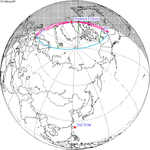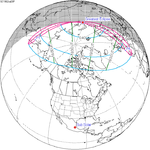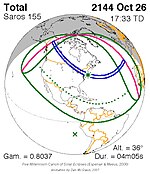Solar eclipse of August 21, 2036
| Solar eclipse of August 21, 2036 | |
|---|---|
| Type of eclipse | |
| Nature | Partial |
| Gamma | 1.0825 |
| Magnitude | 0.8622 |
| Maximum eclipse | |
| Coordinates | 71°06′N 47°00′E / 71.1°N 47°E |
| Times (UTC) | |
| Greatest eclipse | 17:25:45 |
| References | |
| Saros | 155 (7 of 71) |
| Catalog # (SE5000) | 9589 |
A partial solar eclipse will occur on Thursday, August 21, 2036. A solar eclipse occurs when the Moon passes between Earth and the Sun, thereby totally or partly obscuring the image of the Sun for a viewer on Earth. A partial solar eclipse occurs in the polar regions of the Earth when the center of the Moon's shadow misses the Earth.
Images
Related eclipses
Solar eclipses of 2033–2036
This eclipse is a member of a semester series. An eclipse in a semester series of solar eclipses repeats approximately every 177 days and 4 hours (a semester) at alternating nodes of the Moon's orbit.[1]
The partial solar eclipse on July 23, 2036 occurs in the next lunar year eclipse set.
| Solar eclipse series sets from 2033 to 2036 | ||||||
|---|---|---|---|---|---|---|
| Descending node | Ascending node | |||||
| Saros | Map | Gamma | Saros | Map | Gamma | |
| 120 | March 30, 2033 Total |
0.9778 | 125 | September 23, 2033 Partial |
−1.1583 | |
| 130 | March 20, 2034 Total |
0.2894 | 135 | September 12, 2034 Annular |
−0.3936 | |
| 140 | March 9, 2035 Annular |
−0.4368 | 145 | September 2, 2035 Total |
0.3727 | |
| 150 | February 27, 2036 Partial |
−1.1942 | 155 | August 21, 2036 Partial |
1.0825 | |
Saros 155 series
This eclipse is a part of Saros series 155, repeating every 18 years, 11 days, and containing 71 events. The series started with a partial solar eclipse on June 17, 1928. It contains total eclipses from September 12, 2072 through August 30, 2649; hybrid eclipses from September 10, 2667 through October 2, 2703; and annular eclipses from October 13, 2721 through May 8, 3064. The series ends at member 71 as a partial eclipse on July 24, 3190. Its eclipses are tabulated in three columns; every third eclipse in the same column is one exeligmos apart, so they all cast shadows over approximately the same parts of the Earth.
The longest duration of totality will be produced by member 14 at 4 minutes, 5 seconds on November 6, 2162, and the longest duration of annularity will be produced by member 63 at 5 minutes, 31 seconds on April 28, 3046. All eclipses in this series occur at the Moon’s ascending node of orbit.[2]
| Series members 1–16 occur between 1928 and 2200: | ||
|---|---|---|
| 1 | 2 | 3 |
 June 17, 1928 |
 June 29, 1946 |
 July 9, 1964 |
| 4 | 5 | 6 |
 July 20, 1982 |
 July 31, 2000 |
 August 11, 2018 |
| 7 | 8 | 9 |
 August 21, 2036 |
 September 2, 2054 |
 September 12, 2072 |
| 10 | 11 | 12 |
 September 23, 2090 |
 October 5, 2108 |
 October 16, 2126 |
| 13 | 14 | 15 |
 October 26, 2144 |
 November 7, 2162 |
 November 17, 2180 |
| 16 | ||
 November 28, 2198 | ||
Metonic series
The metonic series repeats eclipses every 19 years (6939.69 days), lasting about 5 cycles. Eclipses occur in nearly the same calendar date. In addition, the octon subseries repeats 1/5 of that or every 3.8 years (1387.94 days). All eclipses in this table occur at the Moon's ascending node.
| 20 eclipse events between June 10, 1964 and August 21, 2036 | ||||
|---|---|---|---|---|
| June 10–11 | March 28–29 | January 14–16 | November 3 | August 21–22 |
| 117 | 119 | 121 | 123 | 125 |
 June 10, 1964 |
 March 28, 1968 |
 January 16, 1972 |
 November 3, 1975 |
 August 22, 1979 |
| 127 | 129 | 131 | 133 | 135 |
 June 11, 1983 |
 March 29, 1987 |
 January 15, 1991 |
 November 3, 1994 |
 August 22, 1998 |
| 137 | 139 | 141 | 143 | 145 |
 June 10, 2002 |
 March 29, 2006 |
 January 15, 2010 |
 November 3, 2013 |
 August 21, 2017 |
| 147 | 149 | 151 | 153 | 155 |
 June 10, 2021 |
 March 29, 2025 |
 January 14, 2029 |
 November 3, 2032 |
 August 21, 2036 |
References
- ^ van Gent, R.H. "Solar- and Lunar-Eclipse Predictions from Antiquity to the Present". A Catalogue of Eclipse Cycles. Utrecht University. Retrieved 6 October 2018.
- ^ "NASA - Catalog of Solar Eclipses of Saros 155". eclipse.gsfc.nasa.gov.





